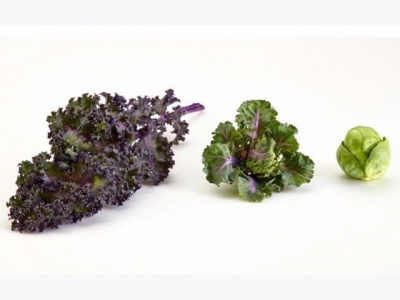How to Grow Kalettes: New Superfood, the Kale and Brussels Sprouts Vegetable Hybrid

Kalettes, also known as BrusselKale and Lollipop Kale, have tall erect stems ringed with small rosettes of kalelike leaves. Their flavor is mild and nutty, growing sweeter after frost.
Kalettes, also known as BrusselKale and Lollipop Kale, have tall erect stems ringed with small rosettes of kalelike leaves. Their flavor is mild and nutty, growing sweeter after frost. Seeds are a little more expensive, since kalettes are a trademarked novelty vegetable. Kalettes require high fertility and a long growing season. They are quickly becoming the new superfood, and are worth the price for seeds.
HOW TO GROW AND CARE FOR KALETTES
There are three varieties of kalettes. “Autumn Star” takes 110 days from seed to maturity, “Mistletoe” 124 days, and “Snow Drop” 138 days. Start seeds indoors and grow them for 4-6 weeks in a greenhouse or on a sunny interior windowsill before transplanting them out.
Johnny’s Seeds, the main retail distributor of kalettes, recommends that Northern growers transplant kalettes outdoors just after the frost-free date. If you’re not sure when that is, check with your local Cooperative Extension. Mid-Atlantic growers transplant kalettes in June and July for a fall harvest, California growers set transplants out in August for fall and early winter harvest, and Deep Southern growers transplant kalettes in September for a fall/winter harvest.
Kalette seeds are also available through Amazon. Here’s a product link for more information: Autumn Star Kalette Seeds.
Like other brassicas, kalettes prefer nitrogen-rich soil. Add a couple of inches of compost and/or well-aged manure to your garden soil before setting your kalettes out. You can add a pinch of blood meal at the roots of each plant for a nitrogen boost. An organic mulch of lawn clippings (from a lawn that’s not treated with herbicides), or short clover directed-seeded just after you set the transplants out, will help to cool the soil, discourage weeds and provide supplemental nitrogen. Spray every 2 weeks with fish emulsion or compost tea for a further nitrogen boost.
Space transplants 18-24″ apart in your beds. Provide them with plentiful and regular water.
If you’re afraid kalettes won’t mature before the growing season ends, you can speed up maturity by pinching off the growing tip of the plant once the lowest rosettes on the stem are 1/2″-3/4″ wide. Pinched tops can be cooked and eaten like kale. Remember that kalette flavor is best after a light frost.
Harvest rosettes when they reach 1 1/2-2″ wide. Rosettes on any given plant will not all mature at once.

KALETTE PESTS, PROBLEMS AND DISEASES
Kalette pests, problems and diseases are similar to those which affect other kale and other brassicas.
Inadequate nitrogen, overly acidic soil or lack of water may stunt plant growth. Nitrogen-boosting is described in the previous section. Acidic soil may be sweetened by the addition of a small amount of wood ash.
If your kalette leaves curl, pucker and turn yellow, you may have an aphid or whitefly infestation. Look on the undersides of leaves for tiny soft-bodied green, brown or pink insects. Aphids can be handpicked or killed with organic insecticidal soap. Ladybugs eat aphids. Soap is the best remedy for whiteflies.
Ragged holes in leaves may be caused by cabbage loopers or cabbage worms, light green yellow-striped caterpillars. Handpick them or spray with Bacillus thuringiensis.
are probably the work of flea beetles. Skeletonized leaves may be caused by the Mexican bean beetle. Leaves chewed to the stem suggest the presence of vegetable weevils.
Pyrethrum spray may control these pests. Pyrethrum is organic but toxic to bees–spray it in the evening when pollinators aren’t active.
Row cover/agricultural fleece spread over transplants and sealed down at the edges may keep insects away from your plants while letting light and water through. Check underneath periodically to make sure you’re not sheltering a hatching of insect pests.
If your kalettes have yellowish spots on their leaves which grow white downy mold in wet weather, they’ve been hit by downy mildew. If you catch it early, try spraying an organic fungicide like copper or Bacillus subtilis. If it’s well advanced, remove and destroy (do not compost) these plants.
Black leg causes sunken areas to develop around the stem near the ground and gray spots to appear on leaves and stems. The whole plant may wilt and die. This is generally incurable; remove and destroy (do not compost) infected plants.
Related news
 Keep This Plant In Your Bedroom Because It Gives You A Oxygen While You Sleep!
Keep This Plant In Your Bedroom Because It Gives You A Oxygen While You Sleep! Sanseveria “Sansevieria trifasciata” is the kind of “Sansevieria” which originates from tropical areas of West Africa, particularly Nigeria and eastern Congo.
 How To Prune Tomatoes For A Big Harvest
How To Prune Tomatoes For A Big Harvest There is one big catch: You should only prune indeterminate varieties, which produce new leaves and flowers continuously through the growing season.
 How to Dry Basil
How to Dry Basil Most people are familiar with basil in its dried, crushed form. Some are familiar with it in its fresh form as well. So how do you get it from fresh to dried?